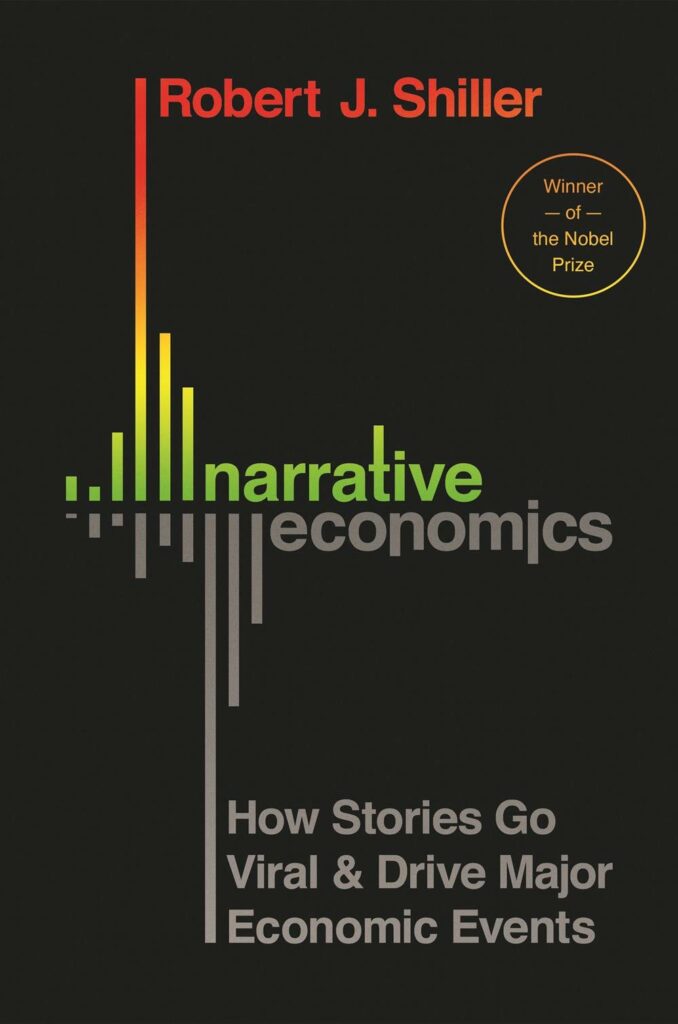
Narrative Economics: How Stories Go Viral & Drive Major Economic Events
by Robert J. Shiller
Princeton University Press, 351 pages
BUY ON AMAZON
We tend to see economics as a cold, calculating beast, one guided by facts and raised on hard figures. But Robert Shiller, the Sterling Professor of Economics at Yale University and Nobel Laureate believes this isn’t the case at all — and argues the point in his book Narrative Economics: How Stories Go Viral & Drive Major Economic Events.
The decisions people make, especially groups of people, are rooted much more deeply in stories (particularly human-interest stories) than hard facts, Shiller believes. Economies are the aggregate product of all individual decisions by producers and consumers, and as such, economic fluctuations are “substantially driven by contagion and oversimplified in easily transmitted variants of economic narratives. These ideas color people’s loose thinking and actions”.
The stories we tell
The idea that human behavior can and does influence markets isn’t new, nor very surprising. What sets Shiller’s thinking apart from the beaten path is the depth he assigns to this influence. The stories we tell and listen to, he argues, influence our behavior, and can thus become self-fulfilling prophecies — if they reach enough people. Understanding the relationships between human narratives and economic reality is what we need to work on if we want to better predict events such as recessions or asset bubbles and how people will react to them.
“Ultimately, the mass of people whose decisions cause economic fluctuations aren’t very well-informed […] yet their decisions drive aggregate economic activity. It must be the case that attention-getting narratives drive those decisions,” the book reads.
To back up his points, Shiller uses detailed accounts of notable economic events in the past and their effects. He tracks the rise and subsequent collapse into obscurity of relevant narratives using data from Google Ngrams, a tool that tracks the frequency with which certain words pop up in written sources such as books and journals throughout time.
One example he cites are the two world wars. When Austria-Hungary declared war on Serbia in July 1914 (which would spark World War I), major stock exchanges in the US and Europe put their activity on hold — which led to widespread uncertainty, then panic. Eventually, large quantities of gold were taken out of the US and shipped to Europe as investments were pulled back. Shiller argues that this was due to narratives that took hold in Europe after the Panic of 1907, which “proved” that the US was unstable and thusly not the best place to keep your wealth during a war.
But in September 1939, right after Britain declared war on Germany, stock markets didn’t close down — in fact, the S&P index rose by 9.6% after the fact. At least part of this, Shiller argues, came down to stories of investors who didn’t pull their assets out of the US and made bank from selling supplies to European countries during the first war.
Were such decisions illogical? Not really, there definitely was some thought put into them. But that mental process was rooted in narratives, Shiller argues, in how people perceived markets and the countries and individual actors that made up said markets.
If stories do have such an outsized effect on economic fluctuations, one question that comes to mind is, How can we tell which ones matter? What makes individual stories powerful is how many people they reach — how ‘viral’ they become. Shiller draws parallels between them and diseases or pathogens, in that they ‘infect’ the collective awareness and ‘spread’ to encompass public discourse. The analogy seems particularly well suited for 2020.
There are also a few signs that a story will catch on and shape public behavior. Novelty, for starters, is very powerful, and novel narratives tend to have a leg up when competing for our attention. But, at the same time, there are a few ‘timeless classics’ that seem to come back again and again, just taking on different shapes to suit each era. Narratives involving either fear or enthusiasm for new technologies are cyclical, as well as moral ones including the need to live a thrifty life (Shiller believes this one, in particular, helped prolong the Great Depression). Narratives involving strong emotions such as fear and anger against certain groups perceived to be selfish or out of touch also seem to follow the same pattern.
These are just a few tidbits of the ideas Shiller attacks in Narrative Economics — and I won’t spoil the rest. The book itself is quite engrossing and pleasantly written; the ideas laid down here are a bit dense sometimes, so these factors definitely help in keeping you going.
One criticism I do have of the book is that Shiller doesn’t always provide sufficient proof, for my tastes, to back up his claims. That’s not to say they’re not worth reflecting on — they definitely are. But Narrative Economics comes off more like a collection of assertions rather than verifiable truth. The simple fact is that after reading through it, I can’t say whether Shiller’s ideas are right or wrong. The only thing I can say for sure is that they’re fascinating and definitely deserving of academic attention. He himself calls for economists to look to other disciplines, including epidemiology and qualitative social research, to better understand how stories drive economic reality — so the book may yet act as a sort of roadmap for further research.
Fittingly, perhaps, until that work is done Narrative Economics: How Stories Go Viral & Drive Major Economic Events will have to remain just that — a narrative that may go viral and drive major economic events.


